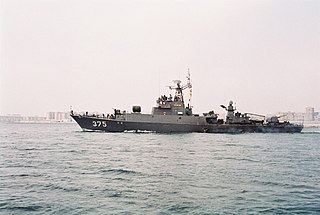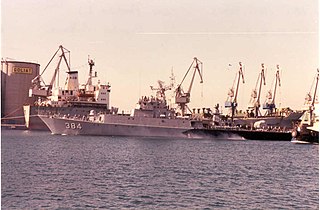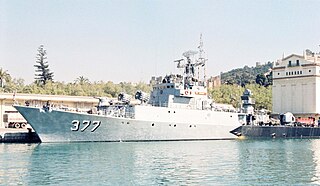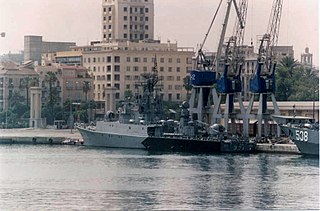
Libyan Navy is the branch of the Libyan military responsible for naval warfare. Established in November 1962, Libyan Navy has been headed by Admiral Mansour Bader, Chief of Staff of the Libyan Naval Force. Before the Libyan Civil War it was a fairly typical small navy with a few missile frigates, corvettes and patrol boats to defend the coastline, but with a very limited self-defence capability. The Navy has always been the smallest of Libya's services and has always been dependent on foreign sources for equipment, spare parts, and training. Most of the Gaddafi era fleet was destroyed in 2011. Since the start of the ongoing internal conflict, the Libyan Navy is aligned with the Government of National Accord (GNA), led by the Presidential Council in Tripoli, apart from coastal patrol vessels under the control of the Libyan National Army.

The People's Liberation Army Navy Surface Force is the surface warfare branch of China's People's Liberation Army Navy (PLAN), consisting of all surface vessels in operational service with the PLAN. The PLAN Surface Force operates 661 ships organized into three fleets: the North Sea Fleet, the East Sea Fleet and the South Sea Fleet.

The Petya class was the NATO reporting name for a class of light frigates designed in the 1950s and built for the Soviet Navy in the 1960s. The Soviet designation was "Storozhevoi Korabl`" Project 159.

The Parchim-class corvette was developed for the East German Navy in the late 1970s, and built by the Wolgast Peene-Werft. The ships were designed for coastal anti-submarine warfare. In case of an all-out NATO-Warsaw Pact war in Europe their prime targets would have been the small U-206 coastal submarines of the West German navy. The first ship, Wismar, was launched on 9 April 1981 in Rostock, and subsequently another 15 ships were built until 1986. To make production more economical, the Soviet Union agreed to purchase another 12 ships from Wolgaster Peenewerft built between 1986 and 1990, thereby effectively subsidising the East German shipbuilding industry.

KRI Imam Bonjol (383) is a Parchim-class corvette currently operated by the Indonesian Navy. Prior to 1994, the Imam Bonjol was part of the East German Volksmarine, as the Teterow (234).

KRI Tjiptadi (381) is a Parchim-class corvette currently operated by the Indonesian Navy. Prior to 1996, the Tjiptadi was part of the East German Volksmarine, as the Bergen (213).

KRI Hasan Basri (382) is a Kapitan Patimura-class corvette currently operated by the Indonesian Navy. Before her service in Indonesia, ship was part of the East German Volksmarine, as Güstrow (223).

KRI Sutedi Senoputra (378) is a Kapitan Patimura-class corvette currently operated by the Indonesian Navy. Before her service in Indonesia, ship was part of the East German Volksmarine, as Parchim (242).

KRI Nuku (373) is a Kapitan Patimura-class corvette currently operated by the Indonesian Navy. Before her service in Indonesia, ship was part of the East German Volksmarine, as Waren (224).

KRI Pati Unus (384) is a Kapitan Patimura-class corvette that used to be operated by the Indonesian Navy. Before her service in Indonesia, ship was part of the East German Volksmarine, as Ludwigslust (232).

KRI Sutanto (377) is a Kapitan Patimura-class corvette currently operated by the Indonesian Navy. Before her service in Indonesia, ship was part of the East German Volksmarine, as Prenzlau / Wismar (241).

KRI Teuku Umar (385) is a Kapitan Patimura-class corvette currently operated by the Indonesian Navy. Before her service in Indonesia, ship was part of the East German Volksmarine, as Grevesmühlen(212).

KRI Sultan Thaha Syaifuddin (376) is a Kapitan Patimura-class corvette currently operated by the Indonesian Navy. Before her service in Indonesia, the ship was part of the East German Volksmarine, as Bad Doberan(222).

KRI Silas Papare (386) is a Kapitan Patimura-class corvette currently operated by the Indonesian Navy. Before her service in Indonesia, ship was part of the East German Volksmarine, as Gadebusch(211).

KRI Cut Nyak Dien (375) is a Kapitan Pattimura-class corvette currently operated by the Indonesian Navy. Before her service in Indonesia, the ship was part of the East German Volksmarine, as Lübz(221).

KRI Lambung Mangkurat (374) is a Kapitan Patimura-class corvette currently operated by the Indonesian Navy. Before her service in Indonesia, the ship was part of the East German Volksmarine, as Angermünde(214).

KRI Memet Sastrawiria (380) is a Kapitan Patimura-class corvette currently operated by the Indonesian Navy. Before her service in Indonesia, the ship was part of the East German Volksmarine, as Bützow(244).
KRI Kapitan Pattimura (371) is a Kapitan Patimura-class corvette currently operated by the Indonesian Navy. Before her service in Indonesia, the ship was part of the East German Volksmarine, as Prenzlau(231).
KRI Untung Surapati (372) is a Kapitan Patimura-class corvette currently operated by the Indonesian Navy. Before her service in Indonesia, the ship was part of the East German Volksmarine, as Ribnitz-Damgarten(233).















